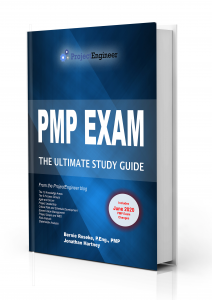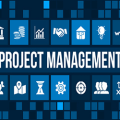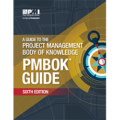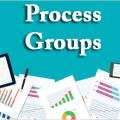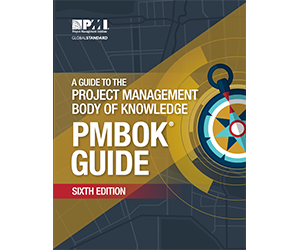
In the Project Management Body of Knowledge (PMBOK) the process groups are the chronological phases that the project goes through, and the knowledge areas occur throughout any time during the process groups. The process groups are horizontal, and the knowledge areas are vertical. They are the core technical subject matter of the project management profession, and they bring the project to life.
These are the 10 Project Management knowledge areas:
- Project Integration Management
- Project Scope Management
- Project Schedule Management
- Project Cost Management
- Project Quality Management
- Project Resource Management
- Project Communications Management
- Project Risk Management
- Project Procurement Management
- Project Stakeholder Management
Project Integration Management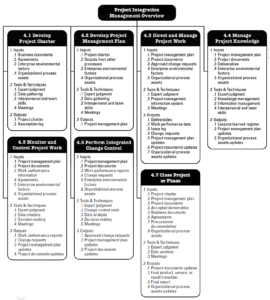
This knowledge area contains the tasks that hold the overall project together and integrate it into a unified whole.
- Develop Project Charter. One of only two processes during the Initiation phase, the development of a project charter initiates the project and authorizes the project manager.
- Develop Project Management Plan. This is the primary guiding document for the project manager and end result of the planning phase. It is used to ensure a successful outcome to the project. The project management plan is distributed and approved by relevant stakeholders, particularly the project sponsor, and changes are tracked through the change log.
- Direct and Manage Project Work. This process encompasses the production of the project’s deliverables.
- Manage Project Knowledge. Most projects require the acquisition of additional knowledge. This requires active management to ensure the project finishes on time and budget.
- Monitor and Control Project Work. This process contains the work necessary to monitor the project, perform earned value analysis and project status reports, and identify potential project changes.
- Perform Integrated Change Control. In this process the change control is carried out. Whether your project requires change request forms, project sponsor approvals, and other adminstration or if its a basic change log, this process manages project changes.
- Close Project or Phase. This process contains the tasks necessary to close the project, or the project phases.
Project Scope Management
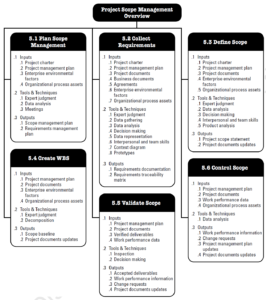 This knowledge area involves the project scope, that is, the work that is included within the project. Since scope changes are one of the top causes of project changes and grief in general, it is very important that the boundaries of the project be well defined from the outset and monitored rigorously. It is very easy for people to insert unauthorized work into the project when the project appears to be big enough to absorb it, but most projects are estimated with the minimum cost.
This knowledge area involves the project scope, that is, the work that is included within the project. Since scope changes are one of the top causes of project changes and grief in general, it is very important that the boundaries of the project be well defined from the outset and monitored rigorously. It is very easy for people to insert unauthorized work into the project when the project appears to be big enough to absorb it, but most projects are estimated with the minimum cost.
When competing for (or obtaining) work, we are motivated towards the minimum scope. But when the project has begun we are motivated towards the maximum.
- Plan Scope Management. The Scope Management Plan is part of the project management plan and can be a section within it rather than a stand alone document.
- Collect Requirements. At this stage the detailed requirements of the final product or service are assembled and itemized.
- Define Scope. A scope statement is created which can be in sentence form or bulleted. You can’t delineate every project boundary, but the scope statement should be comprehensive enough that it reduces some of the major risks to the project.
- Create WBS. A Work Breakdown Structure (WBS) contains either a graphical or table-style breakdown of the project work.
- Validate Scope. During the project the deliverables are “validated” meaning they are approved by the recipient. Note this appears during the Monitoring & Controlling process group, and it refers to the formal acceptance of the deliverables after they have been submitted, not the specifications for the deliverables during the planning phase.
- Control Scope. The scope statement must be revisited regularly in light of the project work that has been completed and current project status. If you are behind schedule, for example, you may wish to gravitate toward a minimum acceptable scope rather than all the bells and whistles you wanted to produce in the beginning.
Project Schedule Management
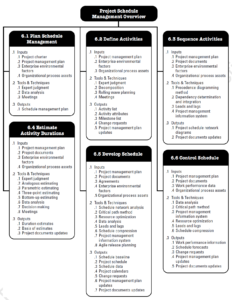 This is usually the most time consuming of the knowledge areas. During planning, the project manager must divide the project into tasks and create both a schedule (start and finish dates for each task) and budget for each task. During the project, earned value management determines the project status at regular status intervals. Because most project changes involve a change to the schedule, it must be continuously re-baselined and the project management plan updated (and approved by the project sponsor).
This is usually the most time consuming of the knowledge areas. During planning, the project manager must divide the project into tasks and create both a schedule (start and finish dates for each task) and budget for each task. During the project, earned value management determines the project status at regular status intervals. Because most project changes involve a change to the schedule, it must be continuously re-baselined and the project management plan updated (and approved by the project sponsor).
- Plan Schedule Management. The Schedule Management Plan contains information such as how the schedule will be created, who will be responsible for it, how aggressive it will be, and under what circumstances it will be changed.
- Define Activities. The project is divided into tasks. Note that according to the PMBOK this process is different from Create WBS within the Scope Management knowledge area, but in practice they are generally the same. A task list is produced which defines all of the project (not most of it!).
- Sequence Activities. The tasks are “sequenced” that is, they are ordered and the relationships between them are established. These relationships take the form of Finish-to-Start (FS), Finish-to-Finish (FF), Start-to-Start (SS) and Start-to-Finish (SF). For small projects with simple schedules this is not necessary.
- Estimate Activity Durations. Using its resource list, a duration is estimated for each task.
- Develop Schedule. Firstly, a network diagram is produced which determines the critical path as well as floats for each task. Secondly, a graphical bar chart schedule is created with each activity plotted on their early start dates. Lastly the resource usage is plotted and tasks are moved along their floats to flatten the resource usage. This is called resource levelling.
- Control Schedule. Earned value analysis is performed on regular project status intervals to determine whether the project is ahead or behind schedule, and by how much, at that status point.
Project Cost Management
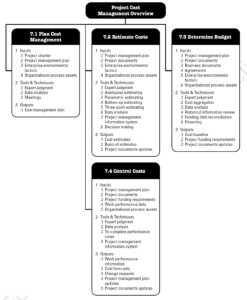 The project budget is usually one of the most sensitive parts of a project. Wouldn’t it be nice to have have project budgets that are comfortable and contain plenty of cushion, but very few projects have this luxury. The budget must be established through rigorous estimating techniques and monitored to ensure there are no unnecessary changes that make stakeholders unhappy.
The project budget is usually one of the most sensitive parts of a project. Wouldn’t it be nice to have have project budgets that are comfortable and contain plenty of cushion, but very few projects have this luxury. The budget must be established through rigorous estimating techniques and monitored to ensure there are no unnecessary changes that make stakeholders unhappy.
- Plan Cost Management. The Cost Management Plan establishes things like the methodologies with which the project budget will be established, the criteria for changes, and control procedures.
- Estimate Costs. The cost of each task is estimated, taking into account the resources, labor, materials, equipment, and any other item of cost necessary to complete the task.
- Determine Budget. The task budgets are rolled up into an overall project budget.
- Control Costs. Earned value analysis is performed on regular project status intervals to determine the project status at that status point.
Project Quality Management
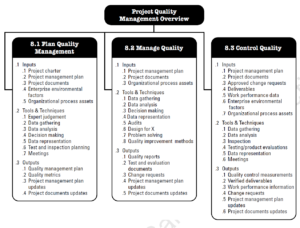 Quality is one of the triple constraints of Time, Cost, and Quality. As such, when you need better quality you need to put in more time or cost. Because of this integral nature of the quality of the project’s deliverables, the quality level should be established during project planning and specified within the project management plan. Then when issues arise regarding product specifications, there is a plan to deal with it.
Quality is one of the triple constraints of Time, Cost, and Quality. As such, when you need better quality you need to put in more time or cost. Because of this integral nature of the quality of the project’s deliverables, the quality level should be established during project planning and specified within the project management plan. Then when issues arise regarding product specifications, there is a plan to deal with it.
- Plan Quality Management. The Quality Management Plan can be a section of the project management plan or a stand alone document, and it contains the quality specifications for the product or service. There should be no doubt whether the product being produced is a Mercedes-Benz or a Pinto.
- Manage Quality. The processes that ensure the quality of the deliverables must be inspected regularly to ensure they are working.
- Control Quality. The deliverables themselves are inspected to ensure they conform to the quality standards.
Project Resource Management
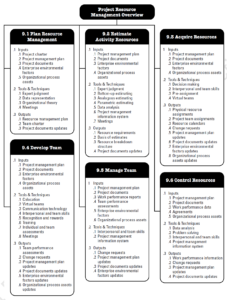 The project team is usually one of the most important factors in the success of a project. If you have a good team, you will have a successful project. This knowledge area is concerned with acquiring the right team, ensuring their satisfaction, and tracking their performance.
The project team is usually one of the most important factors in the success of a project. If you have a good team, you will have a successful project. This knowledge area is concerned with acquiring the right team, ensuring their satisfaction, and tracking their performance.
- Plan Resource Management. The Human Resource Management Plan identifies the roles/positions required by the project, the minimum requirements for those roles, and how they fit into the overall project structure.
- Estimate Activity Resources. To ensure the necessary resources are available, the quantity of each resources needs to be estimated.
- Acquire Resources. Once the required number of resources has been estimated, the resources can be can be acquired.
- Develop Team. The project team often requires training to develop the necessary competencies to complete the project, but the development of the team environment and interaction between team members is also actively managed.
- Manage Team. The project team is actively managed to ensure their production is maximized and they are satisfied.
- Control Resources. The resources are monitored and their performance evaluated to ensure maximum productivity.
Project Communications Management
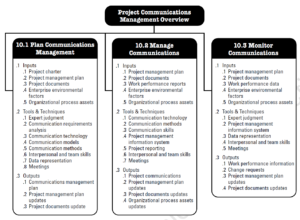 Communication with stakeholders is often the key factor that allows stakeholders to be satisfied even when unexpected changes happen. It is essential to develop a communications plan to keep all stakeholders “in the loop” throughout the project and communicate early and often when unexpected issues occur.
Communication with stakeholders is often the key factor that allows stakeholders to be satisfied even when unexpected changes happen. It is essential to develop a communications plan to keep all stakeholders “in the loop” throughout the project and communicate early and often when unexpected issues occur.
- Plan Communications Management. The Communications Management Plan identifies the regular communication requirements of each stakeholder, such as investor circulars, progress updates, and so forth. It also identifies any specific communications procedures for unexpected issues or project changes.
- Manage Communications. During project execution the communications plan is put into practice and communications are actively managed.
- Monitor Communications. During regular status points the project communications are reviewed and revisions to the communications plan are initiated.
Project Risk Management
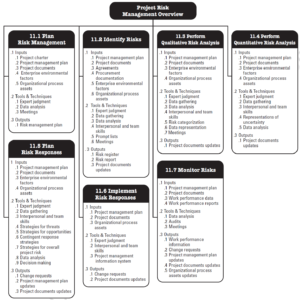 Managing project risk is one of the most underrated aspects of project management. Major risk are very seldom identified up front and analyzed within the project management plan, but when they are project stakeholders tend to forgive the unexpected issues much quicker. Not to mention they hold the project manager in high regard for strong safeguarding of their investments.
Managing project risk is one of the most underrated aspects of project management. Major risk are very seldom identified up front and analyzed within the project management plan, but when they are project stakeholders tend to forgive the unexpected issues much quicker. Not to mention they hold the project manager in high regard for strong safeguarding of their investments.
- Plan Risk Management. The Risk Management Plan identifies how the risks will be itemized, categorized, and prioritized.
- Identify Risks. The major risks to the project are identified and placed into a risk register (list of risks). Most projects have one or two risk that take significant precedence over all others, and these should often get special attention.
- Perform Qualitative Risk Analysis. Once the biggest risks are identified, they are classified into categories of likelihood and impact, and then ranked according to priority.
- Perform Quantitative Risk Analysis. Once the risks are ranked according to priority, the biggest priority risks are numerically analyzed according to their impact to the project budget, schedule, or any other part of the project.
- Plan Risk Responses. For the most important risks, response plans are drafted such that all parties are aware of how to respond to the occurrence of the risk.
- Implement Risk Responses. The risk responses identified in the previous step are carried out.
- Monitor Risks. At regular status points the risk register is inspected and risks that have expired are crossed off.
Project Procurement Management
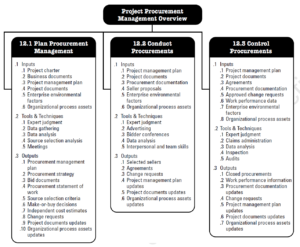 Almost all projects have some form of outside procurement. Hiring subcontractors can get the job done quicker or with better expertise but sacrifices the ability to control the quality, schedule, or other factors. Also, the fine print often results in budget and schedule overruns that were not envisioned.
Almost all projects have some form of outside procurement. Hiring subcontractors can get the job done quicker or with better expertise but sacrifices the ability to control the quality, schedule, or other factors. Also, the fine print often results in budget and schedule overruns that were not envisioned.
- Plan Procurement Management. The Procurement Management Plan identifies the outside procurement needs of the project and parameters under which the contractors will be procured.
- Conduct Procurements. The contractors are hired. This process involves producing the statements of work, terms of reference, request for proposals, and such, as well as soliciting the responses and choosing a vendor.
- Control Procurements. During project execution the contractors must be managed and the contracts monitored to provide early warning of project changes.
Project Stakeholder Management
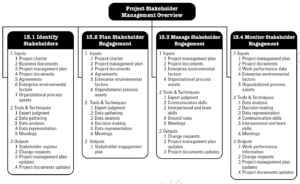 There is nothing more important than the project’s stakeholders. You could, in theory, declare a project a success if the stakeholders are satisfied but the project was a disaster (although I wouldn’t recommend this line of thinking). The stakeholders should be actively managed and addressed within the project management plan.
There is nothing more important than the project’s stakeholders. You could, in theory, declare a project a success if the stakeholders are satisfied but the project was a disaster (although I wouldn’t recommend this line of thinking). The stakeholders should be actively managed and addressed within the project management plan.
- Identify Stakeholders. During the project initiation phase the major stakeholders are identified and their concerns established.
- Plan Stakeholder Engagement. The Stakeholder Management Plan lists each stakeholder and prioritizes their concerns and potential impacts on the project.
- Manage Stakeholder Engagement. During project execution the stakeholders must have their needs addressed and communication lines must remain open.
- Monitor Stakeholder Engagement. During status intervals each stakeholder must be considered to determine if their needs and being addressed and if changes need to made to ensure that they are.
These project management knowledge areas bring the project management process to life and ensure that the project meets its success criteria. Please let me know in the comments how these knowledge areas have worked for you.
UPDATE: This article has been updated to the Sixth Edition of the PMBOK Guide, released in October 2017.
